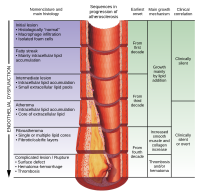
Photo from wikipedia
Objective: This article aims to examine the association between long-term ambient air pollution and progression of subclinical atherosclerosis with 2-year follow-up among midlife women from the Study of Women's Health… Click to show full abstract
Objective: This article aims to examine the association between long-term ambient air pollution and progression of subclinical atherosclerosis with 2-year follow-up among midlife women from the Study of Women's Health Across the Nation (SWAN). Materials and Methods: Carotid duplex ultrasonography was performed in participants from a SWAN ancillary study carried out at the Pittsburgh and Chicago sites. Mean and maximum carotid intima-media thickness (CIMT) and plaque burden were assessed throughout the common, bulb, and internal carotid artery. The yearly mean exposure to PM2.5 (particulate matter) and ozone was generated based on monitors within 20 km of the participants' home. The effect of air pollutants during follow-up on progression of CIMT was estimated using linear mixed-effects models, and the effect on progression of plaque presence and plaque index, a measure of extent of plaque, was evaluated using logistic regression. Results: This study included 417 (257 White and 160 Black) women with a mean age of 51 years at baseline. A 1 μg/m3 higher yearly mean exposure to PM2.5 during follow-up was associated with a 4.28 (95% confidence interval [CI]: 0.02-8.54) μm/year increase in maximum CIMT, after adjusting for socioeconomic and traditional cardiovascular disease (CVD) risk factors. Exposure to PM2.5 contributed to a 30% (95% CI: 3%-65%) higher odds of plaque index progression adjusting for socioeconomic factors only. Conclusions: PM2.5 independently contributed to progression of subclinical atherosclerosis, among women transitioning through menopause, a time of increasing CVD risk. Yet no significant associations between ozone and subclinical atherosclerosis were observed.
Journal Title: Journal of women's health
Year Published: 2019
Link to full text (if available)
Share on Social Media: Sign Up to like & get
recommendations!